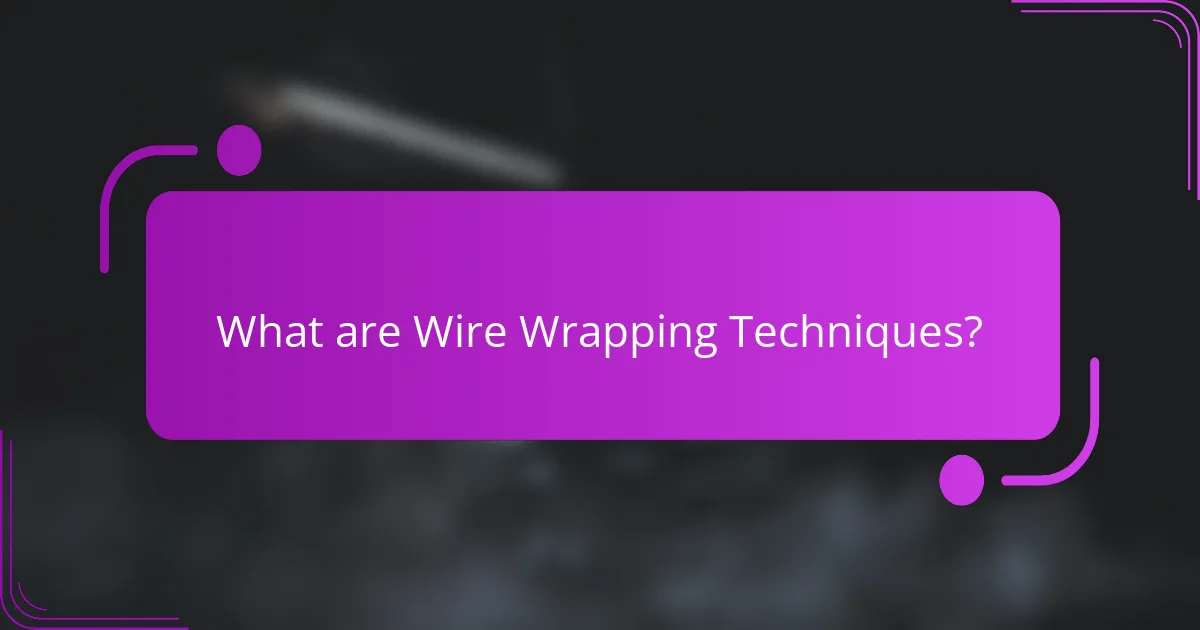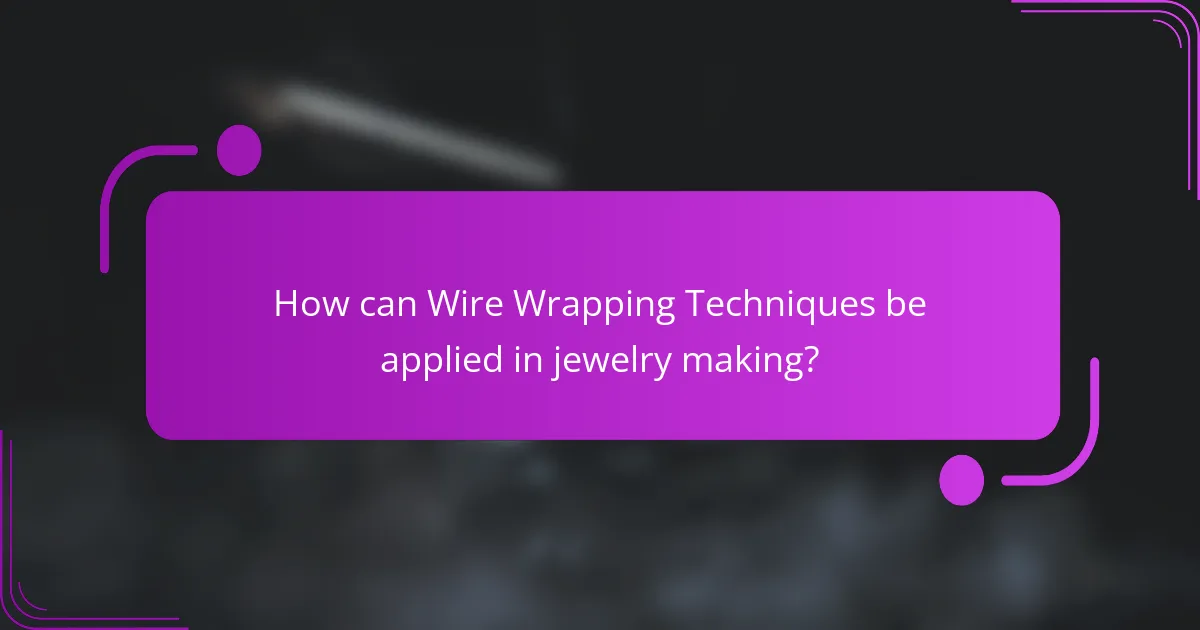Wire wrapping techniques are methods used in jewelry making to securely wrap wire around stones and other materials, creating various styles such as loops, spirals, and intricate designs. This technique is favored for its versatility and ease of learning, allowing artisans to craft personalized jewelry pieces without soldering. Different wire materials, including silver, gold, and copper, provide unique aesthetic qualities and durability. The article explores the applications of wire wrapping in creating pendants, earrings, and bracelets, as well as the importance of selecting the appropriate wire gauge for desired effects. Additionally, it emphasizes the significance of practice, quality tools, and community engagement in mastering wire wrapping skills.

What are Wire Wrapping Techniques?
Wire wrapping techniques are methods used to create jewelry by wrapping wire around stones or other materials. These techniques can involve various styles, such as simple loops, spirals, or intricate designs. Wire wrapping allows for secure settings for gemstones without the use of soldering. It is a popular technique among jewelry makers due to its versatility and ease of learning. The wire used can be made from different metals, including silver, gold, and copper. Each type of wire offers unique aesthetic qualities and durability. Wire wrapping is often used in artisan jewelry, allowing for personalized and custom designs. The technique has roots in ancient jewelry-making practices, demonstrating its long-standing appeal.
How do Wire Wrapping Techniques differ from other jewelry-making methods?
Wire wrapping techniques differ from other jewelry-making methods by focusing on the use of wire to connect and secure components. Unlike traditional methods such as soldering, wire wrapping does not require heat or additional materials. This technique allows for greater flexibility in design and the ability to create intricate patterns. Wire wrapping can incorporate various materials, including gemstones and beads, without altering their structure. Additionally, it permits easy adjustments and repairs, making it user-friendly for beginners. Historical evidence shows that wire wrapping has been used for centuries, highlighting its enduring popularity and versatility in jewelry making.
What are the fundamental principles of Wire Wrapping?
Wire wrapping is a technique used to create jewelry by twisting and shaping wire around stones or other materials. The fundamental principles include using appropriate wire gauge for stability and aesthetics. Proper tools, such as pliers and cutters, are essential for effective manipulation. Consistent tension while wrapping ensures durability and a polished look. Understanding the properties of wire, including flexibility and strength, is crucial for successful designs. Additionally, mastering basic techniques like loops and spirals enhances creativity and functionality in wire-wrapped pieces.
Why is Wire Wrapping a popular choice among jewelry makers?
Wire wrapping is a popular choice among jewelry makers due to its versatility and ease of use. This technique allows artisans to create intricate designs without the need for soldering. Wire wrapping can accommodate a variety of materials, including gemstones, beads, and crystals. It enables makers to express creativity through unique patterns and styles. Additionally, wire wrapping requires minimal tools, making it accessible for beginners. The technique also allows for quick assembly, which is beneficial for producing items in bulk. Many jewelry makers appreciate the durability of wire-wrapped pieces, as they can withstand everyday wear. Overall, wire wrapping combines artistic expression with practicality, contributing to its popularity in the jewelry-making community.
What tools are essential for Wire Wrapping?
Essential tools for wire wrapping include round-nose pliers, chain-nose pliers, and wire cutters. Round-nose pliers are used to create loops and curves in wire. Chain-nose pliers help grip and bend wire securely. Wire cutters are necessary for trimming wire to desired lengths. A ruler or measuring tape aids in precise measurements. Additionally, a work surface or mat protects both the jewelry and the workspace. These tools are fundamental for effective wire wrapping techniques in jewelry making.
Which types of wire are best for Wire Wrapping?
The best types of wire for wire wrapping are typically copper, silver, and gold-filled wire. Copper wire is favored for its malleability and affordability. It is easy to work with and holds its shape well. Silver wire offers a more luxurious finish and is also malleable. Gold-filled wire provides a high-end look without the cost of solid gold. It is durable and resistant to tarnishing. Each type of wire has its unique attributes that make it suitable for various wire wrapping techniques.
What tools are necessary for effective Wire Wrapping?
Effective wire wrapping requires specific tools. Essential tools include round-nose pliers for creating loops. Chain-nose pliers help in gripping and bending wire. Wire cutters are necessary for trimming excess wire. A ruler or measuring tape ensures accurate lengths. Additionally, a nylon-jaw plier prevents wire marring. Finally, a mandrel or dowel aids in forming consistent shapes. These tools collectively enhance the wire wrapping process and ensure quality results.
What styles of Wire Wrapping can be explored?
Common styles of wire wrapping include the following: the spiral wrap, the coiled wrap, and the woven wrap. The spiral wrap involves creating spirals around a central object. The coiled wrap consists of tightly wound coils that secure stones or beads. The woven wrap uses multiple strands of wire to create intricate patterns. Each style offers unique aesthetic and functional qualities. These techniques are widely used in jewelry making. They allow artists to personalize their creations. Wire wrapping can also enhance the structural integrity of the piece.
How do different styles of Wire Wrapping influence jewelry design?
Different styles of wire wrapping significantly influence jewelry design by altering aesthetics and structural integrity. Each style, such as coiling, weaving, and binding, brings unique visual elements. Coiling creates intricate patterns that enhance the overall design. Weaving techniques introduce texture and complexity, contributing to a more dynamic appearance. Binding styles provide stability, ensuring that gemstones remain securely attached. These variations allow artisans to express creativity while meeting functional requirements. Historical trends in wire wrapping show its evolution, reflecting cultural influences on jewelry aesthetics. For example, ancient Egyptian jewelry often featured elaborate wire designs that emphasized craftsmanship. Thus, the choice of wire wrapping style directly impacts both the look and durability of the finished piece.
What are the characteristics of popular Wire Wrapping styles?
Popular wire wrapping styles include the spiral, the weave, and the cage. The spiral style features tightly coiled wire around a focal point. This method is often used to create pendants. The weave style involves intertwining multiple strands of wire for a textured effect. This technique is common in bracelets and earrings. The cage style encases stones or beads within a wire framework. It provides both security and aesthetic appeal. Each style showcases different design elements and craftsmanship. These characteristics reflect the versatility of wire wrapping in jewelry making.

How can Wire Wrapping Techniques be applied in jewelry making?
Wire wrapping techniques can be applied in jewelry making to create intricate designs and secure gemstones. These techniques involve using wire to wrap around stones or other components, forming a stable structure. Common applications include making pendants, earrings, and bracelets.
Artisans can use various wire gauges for different effects. Thicker wire provides strength, while thinner wire allows for delicate details. Wire wrapping also enables the incorporation of multiple stones in a single piece.
This method enhances creativity by allowing for unique shapes and patterns. Additionally, wire wrapping is versatile, suitable for both beginners and experienced jewelers. The popularity of wire wrapping in the jewelry industry reflects its effectiveness in producing visually appealing pieces.
What types of jewelry can be created using Wire Wrapping?
Wire wrapping can create various types of jewelry, including rings, necklaces, bracelets, and earrings. Rings can be designed with intricate wire patterns and gemstones. Necklaces often feature wire-wrapped pendants or beads. Bracelets can incorporate multiple strands of wire with wrapped elements. Earrings may consist of wire-wrapped stones or decorative shapes. Each type showcases the versatility of wire wrapping techniques. This method allows for unique designs and personal expression in jewelry making.
How does Wire Wrapping enhance the aesthetics of jewelry pieces?
Wire wrapping enhances the aesthetics of jewelry pieces by adding intricate designs and textures. This technique allows for the incorporation of various materials, such as gemstones and beads. The flexibility of wire enables artisans to create unique shapes and patterns. These designs can be tailored to individual preferences, making each piece distinctive. Additionally, wire wrapping can provide structural support to delicate components. The visual appeal is further enhanced through the use of different wire gauges and finishes. This creates contrast and depth in the overall design. Overall, wire wrapping elevates jewelry aesthetics by combining artistry with functionality.
What are some unique applications of Wire Wrapping in jewelry?
Wire wrapping in jewelry has unique applications such as creating intricate pendants, securing gemstones, and crafting unique earrings. This technique allows artisans to manipulate wire into various shapes and designs. For pendants, wire wrapping can enhance the visual appeal of stones by forming decorative cages. When securing gemstones, wire wrapping provides stability while showcasing the stone’s natural beauty. In earrings, wire wrapping can create artistic designs that are lightweight yet durable. Additionally, wire wrapping can be used to create custom rings that fit specific sizes and styles. This versatility makes wire wrapping a popular choice among jewelry makers.
What are the benefits of using Wire Wrapping Techniques in jewelry design?
Wire wrapping techniques in jewelry design offer several benefits. They allow for creative expression through intricate designs. Wire wrapping enhances the stability of gemstones and beads, securing them without the use of adhesives. This technique also permits easy adjustments and repairs, making it user-friendly for both beginners and experienced jewelers. Additionally, wire wrapping can be a cost-effective method, as it requires minimal tools and materials. It provides versatility in combining different materials, such as metals and stones, to create unique pieces. Furthermore, wire-wrapped jewelry often stands out due to its handmade quality, appealing to consumers seeking personalized items. These benefits make wire wrapping a popular choice in the jewelry design community.
How does Wire Wrapping contribute to the durability of jewelry?
Wire wrapping enhances the durability of jewelry by securely binding components together. This technique uses metal wire to create a strong connection between stones, beads, and other materials. The tightly wrapped wire prevents movement and reduces the risk of breakage. Additionally, wire wrapping can distribute stress evenly across the piece. This minimizes wear and tear over time. The materials used in wire wrapping, such as copper or sterling silver, also contribute to longevity. These metals resist corrosion and maintain structural integrity. Overall, wire wrapping techniques lead to more robust and long-lasting jewelry designs.
What creative advantages does Wire Wrapping offer to designers?
Wire wrapping offers designers versatility in creating unique jewelry pieces. This technique allows for intricate designs that can incorporate various materials. Designers can easily manipulate wire to form shapes and structures that enhance aesthetics. Additionally, wire wrapping enables the incorporation of gemstones and beads without the need for additional findings. This reduces material costs and simplifies the design process. The technique also allows for customization, as each piece can be tailored to individual preferences. Furthermore, wire wrapping is a skill that can be learned with minimal tools, making it accessible for many designers.

What are some best practices for mastering Wire Wrapping Techniques?
To master wire wrapping techniques, practice consistently and focus on precision. Use quality tools like pliers and wire cutters for accuracy. Select the appropriate gauge of wire for your project to ensure durability. Familiarize yourself with various wire wrapping styles to expand your skills. Begin with simple designs before progressing to complex ones. Follow detailed tutorials or instructional videos for guidance. Regularly assess your work for consistency and make adjustments as needed. Engaging with a community of wire artists can provide valuable feedback and inspiration.
How can beginners effectively learn Wire Wrapping?
Beginners can effectively learn wire wrapping by following structured steps. First, they should gather essential tools such as wire cutters, pliers, and a variety of wires. Next, they can find online tutorials and videos that demonstrate basic techniques. Practicing simple projects, like wire-wrapped pendants, helps build skills. Joining local or online crafting communities provides support and feedback. Additionally, attending workshops can enhance hands-on experience. Regular practice is crucial for mastering the craft. Research shows that consistent practice improves skill retention and technique proficiency.
What common mistakes should be avoided in Wire Wrapping?
Common mistakes to avoid in wire wrapping include using the wrong gauge of wire. This can lead to structural weaknesses in the design. Another mistake is not securing the wire ends properly. Loose ends can cause the piece to fall apart. Additionally, failing to plan the design before starting can result in wasted materials. Over-twisting the wire can also create a messy appearance. Not using the right tools can hinder the wrapping process. Lastly, neglecting to practice can limit skill development. Each of these mistakes can significantly impact the quality of wire-wrapped jewelry.
What resources are available for improving Wire Wrapping skills?
Books on wire wrapping techniques provide foundational knowledge. “Wire Wrapping for Beginners” by George H. McKenzie is a recommended resource. Online courses on platforms like Skillshare and Udemy offer structured learning. YouTube channels dedicated to jewelry making feature tutorials on wire wrapping. Community forums and groups on social media allow for skill sharing and feedback. Local craft stores often host workshops for hands-on practice. Additionally, instructional DVDs can provide visual guidance. These resources collectively enhance wire wrapping skills through varied learning methods.
What tips can enhance the Wire Wrapping experience?
To enhance the wire wrapping experience, use high-quality wire for better flexibility and durability. Choose wire that suits your project, such as copper for its ease of manipulation. Proper tools, like round-nose pliers and wire cutters, are essential for precise work. Practice different wrapping techniques to develop your skill and find your style. Keep your workspace organized to avoid losing materials and improve efficiency. Experiment with various bead types and sizes to add creativity to your designs. Lastly, patience is crucial; take your time to ensure each wrap is secure and aesthetically pleasing.
How can one choose the right materials for successful Wire Wrapping?
To choose the right materials for successful wire wrapping, consider the type of wire and the stones or beads used. The wire should be malleable yet strong, typically made of copper, silver, or gold-filled materials. Copper wire is popular for beginners due to its affordability and ease of manipulation. The gauge of the wire is crucial; thicker wire offers more strength, while thinner wire allows for intricate designs. Select stones that complement the wire’s strength; heavier stones require thicker wire to support their weight. Additionally, consider the finish of the wire; polished wire provides a sleek look, while oxidized wire offers a vintage appearance. Proper material selection enhances both the aesthetics and durability of the final piece.
What techniques can improve the precision of Wire Wrapping projects?
Using proper tools enhances the precision of wire wrapping projects. Precision tools like needle-nose pliers and wire cutters allow for accurate bends and cuts. Employing a wire jig can help create consistent shapes and patterns. Measuring and marking wire lengths before cutting ensures uniformity. Practicing with different wire gauges improves handling and control. Using high-quality wire reduces the likelihood of kinks and breaks. Additionally, maintaining a steady hand while wrapping leads to cleaner results. These techniques collectively contribute to achieving greater precision in wire wrapping.
Wire wrapping techniques are methods used in jewelry making that involve wrapping wire around stones or other materials to create secure and intricate designs. This article explores the fundamental principles of wire wrapping, the essential tools required, and the various styles that can be employed, such as spiral, coiled, and woven wraps. It also discusses the benefits of wire wrapping, including its durability and versatility, along with tips for beginners to effectively learn and master the craft. Additionally, the article highlights unique applications of wire wrapping in creating different types of jewelry, emphasizing its role in enhancing aesthetics and personal expression.